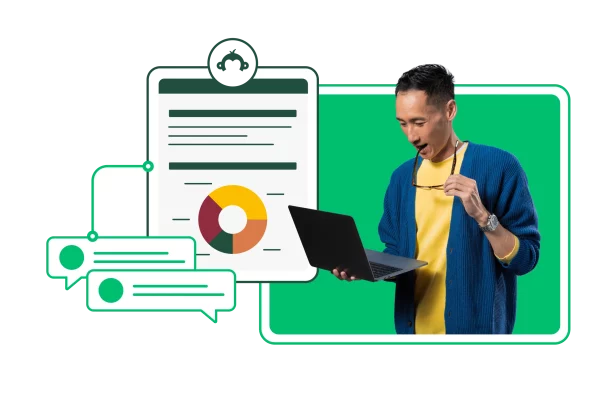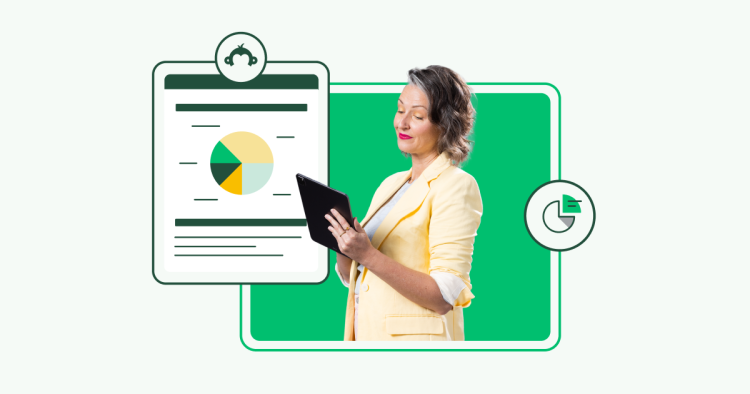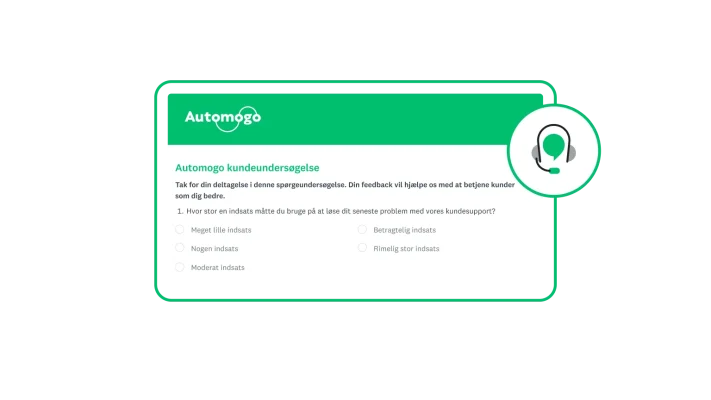Fokusgrupper og spørgeundersøgelser til kunde- og markedsanalyse

Uanset om du søger konkurrencedygtig indsigt eller har brug for at styrke kundeloyaliteten, er kundefeedback et af dine mest værdifulde værktøjer.
Hvorfor? Feedback fra kunder hjælper dig med at forstå, hvad du gør rigtigt og forkert og giver dig de oplysninger, du skal bruge for at foretage forbedringer. Men der er forskellige måder at indsamle kundefeedback på. Mere specifikt er du nødt til at vælge mellem fokusgrupper eller spørgeundersøgelser.
Vi har udviklet en guide til fordele og ulemper ved fokusgrupper og spørgeundersøgelser for at hjælpe dig med at beslutte, hvad du skal vælge – og hvornår du skal bruge hvad for at få kundeindsigt.
Hvad er en fokusgruppe?
Når en researcher gennemfører en fokusgruppe, udvælger man omhyggeligt nogle få personer, der repræsenterer en specifik målgruppe eller en bestemt brugerpersona. Researcheren stiller spørgsmålene i fokusgruppen og faciliterer en diskussion mellem gruppedeltagerne. Typisk vil en fokusgruppe være interaktiv og finde sted på et neutralt område, hvor deltagerne føler sig godt tilpas og trygge ved at skulle sige deres ærlige mening.
Per definition er en fokusgruppe designet til at give sonderende kvalitativ indsigt i modsætning til konkluderende kvantitative analysedata. Det er fordi, du ikke analyserer et stort datasæt. I stedet lytter du til holdninger og perspektiver samt personlige historier og anekdoter. Det kan skabe et større billede af din kundeoplevelse eller din målgruppe, men du får ikke afgørende bevis for, at det gælder for den større population, som du gerne vil nå.
Når det er sagt, kan den data, du får fra en fokusgruppe give værdifuld indsigt i, hvordan dine kunder tænker – og hvorfor de tænker, som de gør. Denne analysemetode kan hjælpe dig med at udvikle et produkt, der passer til dit marked, udvikle engagerende reklamekampagner eller reagere på ændringer i markedet.
Hvad er en spørgeundersøgelse?
Spørgeundersøgelser er en analysemetode, der bruges til at indsamle feedback fra en gruppe mennesker. Spørgeundersøgelser bliver ofte klassificeret som kvantitativ analyse, og resultaterne kan være konkluderende i modsætning til resultaterne fra en fokusgruppe.
Med en spørgeundersøgelse kan du stille spørgsmål og måle stort set alt. Den kan være kort, helt ned til et enkelt spørgsmål, eller indeholde flere hundrede forskellige spørgsmål. Svarformaterne omfatter multiple choice, vurderingsskalaer og åbne spørgsmål.
Spørgeundersøgelser har stor fleksibilitet, hvad angår budget og timing. Men de kan også blive opfattet som ufleksible, for når først du begynder at køre en spørgeundersøgelse, skal du ikke foretage for mange ændringer. Dine spørgsmål skal være konsekvente for at indsamle præcise data.

Fokusgrupper vs. spørgeundersøgelser – hvad skal bruges hvornår?
Inden du vælger et fokusgruppepanel eller en spørgeundersøgelse, skal du forfatte dine spørgsmål til undersøgelsen. Og så skal du stille flere spørgsmål om disse spørgsmål. Med andre ord, du skal tænke over, hvilke oplysninger du har brug for, når du skal gennemføre din undersøgelse.
- Kan du få tilfredsstillende svar med envejsspørgsmål, eller vil en samtale være bedre?
- Vil du teste et koncept eller er en brugeroplevelse, der måske kræver mere forklaring?
- Vil du selv observere deltagernes reaktioner?
- Vil du være okay med at tage beslutninger, der er baseret på få personers meninger og holdninger?
- Har du brug for feedback fra en større stikprøvestørrelse til statistisk signifikante resultater?
Du kan bruge en fokusgruppe til at komme tættere på dine kunder eller din målgruppe. Lyt til, hvad der motiverer og glæder dem, og sæt dig ind i deres problemer og smertepunkter. Den indsigt, du får, kan understøtte dit nye produkt eller ydelse, give dig konkurrencedygtig indsigt eller styrke dit Voice of the Customer-program (VoC).
Spørgeundersøgelser er ofte knyttet til særlige begivenheder, og du kan analysere de indsamlede data med henblik på at foretage målrettede og specifikke forbedringer i din organisation. Du kan f.eks. sende en spørgeundersøgelse om feedback på kundeservice til alle kunder, som har været i kontakt med dit team. Den feedback, du får, kan hjælpe dig med at overvåge nøglemålinger for kundeservice og foretage målrettede forbedringer.

Fordele og ulemper ved fokusgrupper og spørgeundersøgelser
Er du stadig i tvivl, om du skal bruge en fokusgruppe eller en spørgeundersøgelse? Her er en nyttig liste, der kan hjælpe dig med at beslutte, hvad du skal vælge til din kunde- eller markedsanalyse.
Fokusgrupper
Fordele
- Få kundefeedback med kundernes egne ord.
- Opdag idéer og smertepunkter, som dit interne team måske ikke har overvejet, men som er vigtige for dine kunder.
- Få fleksibilitet til at dykke dybere ned i emner, der opstår undervejs i diskussionen.
- Få mulighed for uddybning af kundefeedback ved hjælp af opfølgende spørgsmål.
Ulemper
- Der kan være omkostninger til rekruttering af deltagere, lokaleleje, betaling til moderator og/eller bureau, godtgørelse af deltagere, rejseudgifter til flere lokationer for at se grupper m.m.
- Du kan få skævvredne resultater på grund af dominerende deltagere, der overtager en gruppediskussion.
- Det kan være svært at rekruttere kvalificerede deltagere på grund af den tid, der skal afsættes til deltagelse.
- Der skal lægges tid og kræfter i at planlægge, organisere, rekruttere og (potentielt) rejse.
Spørgeundersøgelser
Fordele
- Få hurtig feedback. Alt efter antallet af respondenter kan du få resultater inden for 24-48 timer.
- Muliggør design af en analyse, hvor samme undersøgelse kan sendes ud over tid. (Det gør det også nemt at benchmarke og overvåge resultater.)
- Hvis din spørgeundersøgelse tillader anonyme besvarelser, kan deltagerne følge sig mere trygge og give helt ærlig feedback.
- Du kan nå ud til mere end en type kunde samtidig og opdele dine data efter en hvilken som helst variabel.
Ulemper
- Du kan få problemer med at rekruttere deltagere til kunde- og markedsanalyser, hvis du ikke har dine kunders kontaktoplysninger.
- Du har ikke mulighed at stille opfølgende spørgsmål og få uddybende feedback.
- Deltagere har ikke mulighed for at give proaktiv feedback på emner, som ikke er omfattet af spørgeundersøgelsen.
- Der er begrænsninger for, hvad du kan spørge om, fordi længden af spørgeundersøgelser har en betydning. Mange er mindre tilbøjelige til at give gennemtænkte, komplette besvarelser på længere spørgeundersøgelser.
Begge analysetyper kræver den samme forberedelse.
Sådan gennemfører du en succesfuld fokusgruppe eller spørgeundersøgelse
1. Målsætning
Inden du skriver din spørgeundersøgelse eller afholder din fokusgruppe, skal du sætte et mål for din analyse. Målet er det, du har brug for at gøre, hvis du skal videre frem eller træffe en beslutning.
Når du har fastlagt dit mål eller dine mål (ikke for mange!), kan du finjustere spørgsmålene til din spørgeundersøgelse eller fokusgruppe. Uanset hvad, vil dine respondenter og gruppedeltagere takke dig.
Desuden kan du, når du definerer dine mål, sikre, at din analyse stemmer overens med virksomhedens mål eller relevante KPI'er. Det er også en god idé at samarbejde med primære interne interessenter for at sikre, at du stiller spørgsmål, der giver brugbar information.
2. Rekruttering af deltagere
Hvem skal deltage i din spørgeundersøgelse eller fokusgruppe? Og lige så vigtigt – hvem skal ikke deltage?
Dine deltagere er afgørende for din analyses succes. Så tænk på deltagernes demografi, herunder alder, køn, husstandsindkomst, erhverv, og hvor de bor.
Har du deres kontaktoplysninger, eller har du brug for et analysepanel til at hjælpe dig med at undersøge dit målmarked? Ønsker du, at respondenter eller deltagere skal kende dit produkt eller din produktkategori?
Hvis du har brug for hjælp til at finde de rigtige mennesker til at deltage i din spørgeundersøgelse, kan SurveyMonkey Audience kontakte stort set alle, der opfylder dine kriterier.
3. Udvikling af en guide til fokusgruppediskussion
Guide til fokusgruppediskussion er et manuskript til moderatoren i en fokusgruppe. Guiden strukturerer samtalen, driver diskussionen, sikrer at målene bliver behandlet og engagerer alle deltagere. Inden du udvikler en diskussionsguide, skal du overveje følgende:
- Hvilke spørgsmål skal moderatoren stille?
- Hvad skal moderatoren vide om dit projekt for at kunne besvare deltagernes spørgsmål?
- Hvis du tester et koncept eller en prototype, hvilke stikord eller hints skal moderatoren kunne give deltagerne?
- Hvad skal moderatoren vide om dine mål med analysen, så de kan stille de rette opfølgende spørgsmål?
Hvis du arbejder med en researcher, skal du starte med mål og målsætninger for din fokusgruppe, og de skal stemme overens med din virksomheds mål. Du skal samarbejde med moderatoren for at sikre, at spørgsmålene bliver stillet på den rette måde og ikke overvælder deltagerne i gruppen med for mange emner eller opgaver.
4. Skriv gode spørgsmål til spørgeundersøgelser
Følg denne bedste praksis for at skrive gode spørgsmål til din spørgeundersøgelse og undgå typiske fejl:
- Undgå ledende og ladede spørgsmål.
- Stil ikke dobbelte spørgsmål.
- Vær forsigtig, når du stiller følsomme spørgsmål i en spørgeundersøgelse.
- Brug et klart og tydeligt sprog.
- Brug den rigtige spørgsmålstype.
Husk at holde fokus. Dit mål bliver underbygget af de spørgsmål, du stiller. Uanset om du opretter en transaktionel vs. relationel spørgeundersøgelse eller balancerer antallet af lukkede vs. åbne spørgsmål, skal du altid sørge for at have målet for øje.
Hvis du stadig har brug for hjælp til at oprette pålidelige spørgeundersøgelser og spørgsmål, kan du bruge vores ekspertforfattede skabeloner til spørgeundersøgelser. Eller tjek Byg med AI, som du kan prompte til at skrive hele din spørgeundersøgelse.
5. Overvej at forberede fokusgruppedeltagerne
Hvis en fokusgruppesamtale skal være udbytterig, skal du overveje at forberede deltagerne. Forberedelse kan afstemme forventningerne, så deltagerne føler sig trygge ved at deltage i gruppesamtalen.
Forberedelse af deltagere kan se sådan ud:
- Del tid, sted og varighed for afholdelse af fokusgruppen.
- Informér deltagerne om diskussionsemnerne.
- Forklar eventuelle regler eller politikker, inkl. eventuelle fortrolighedsaftaler.
Skal deltagerne forberede sig inden undersøgelsen? Du kan overveje at aftale et telefonopkald eller sende en e-mail for at informere fokusgrupppedeltagerne.
6. Afsæt budget til kompensation
Afvej fordele og ulemper ved at kompensere kunderne for deltagelse. Hvor meget, hvis noget, kan du afsætte til at kompensere for deltagernes tid? I længere spørgeundersøgelser eller fokusgrupper, der varer mere end en time, kan du overveje at give et gavekort.
Du skal være forsigtig med, hvor mange penge du tilbyder. Hvis beløbet er for højt, kan der være personer som deltager i spørgeundersøgelsen eller fokusgruppen, som ikke er kvalificerede. Hvis beløbet er for lavt, kan nogle personer være mindre motiverede til at give dig gennemtænkte besvarelser.
De sidste tips til fokusgrupper vs. spørgeundersøgelser
En tommelfingerregel siger, at hvis du ønsker at have en samtale med dine kunder, som skal give en retning, skal du vælge en fokusgruppe. Hvis du derimod har veldefinerede spørgsmål og behov for at komme ud til en stor gruppe eller til flere forskellige kundegrupper, vil en spørgeundersøgelse være det rette valg.
Heldigvis behøver du ikke kun vælge én metode til hvert projekt. De indsigter, som du får fra spørgeundersøgelser og fokusgrupper kan supplere hinanden. Spørgeundersøgelser kan give dig de kvantitative data og statistisk signifikante resultater, som du skal bruge til at drage konklusioner. Mens fokusgrupper kan give din målgruppe eller kunder en stemme og underbygge dine data med det bagvedliggende "hvorfor".
Effektiv udforskning af din målgruppe
Er du klar til at køre en fokusgruppe eller en spørgeundersøgelse? SurveyMonkey kan styrke din markedsanalyse. Test annoncer og nye koncepter, overvåg brandtilstanden, og få konkurrencedygtig indsigt, for blot at nævne et par eksempler. Læs mere om at nå din målgruppe.
Se flere ressourcer

Manager for brandmarkedsføring
Managere indenfor brandmarkedsføring kan bruge denne værktøjspakke til at sætte sig ind i din målgruppe, udvikle dit brand og dokumentere afkast.

Statistikker om AI i markedsføring, du skal kende i 2025
88 % af markedsføringsmedarbejdere bruger AI dagligt. Se, hvordan markedsføringsmedarbejdere vil bruge AI i 2025, og hvordan du kan være på forkant.

Se SurveyMonkeys løsninger til forbrugerprodukter og -tjenester
Branchen for forbrugerprodukter og -tjenester – inkl. forbrugsvarer, rejse- og hotelbranchen – anvender indsigt fra SurveyMonkey til at præge fremtiden.

Undersøg løsninger fra SurveyMonkey til detailhandel
Se, hvordan SurveyMonkey hjælper detailvirksomheder med at navigere de skiftende tendenser, udvikle produkter, der begejstrer, og opbygge afholdte brands.